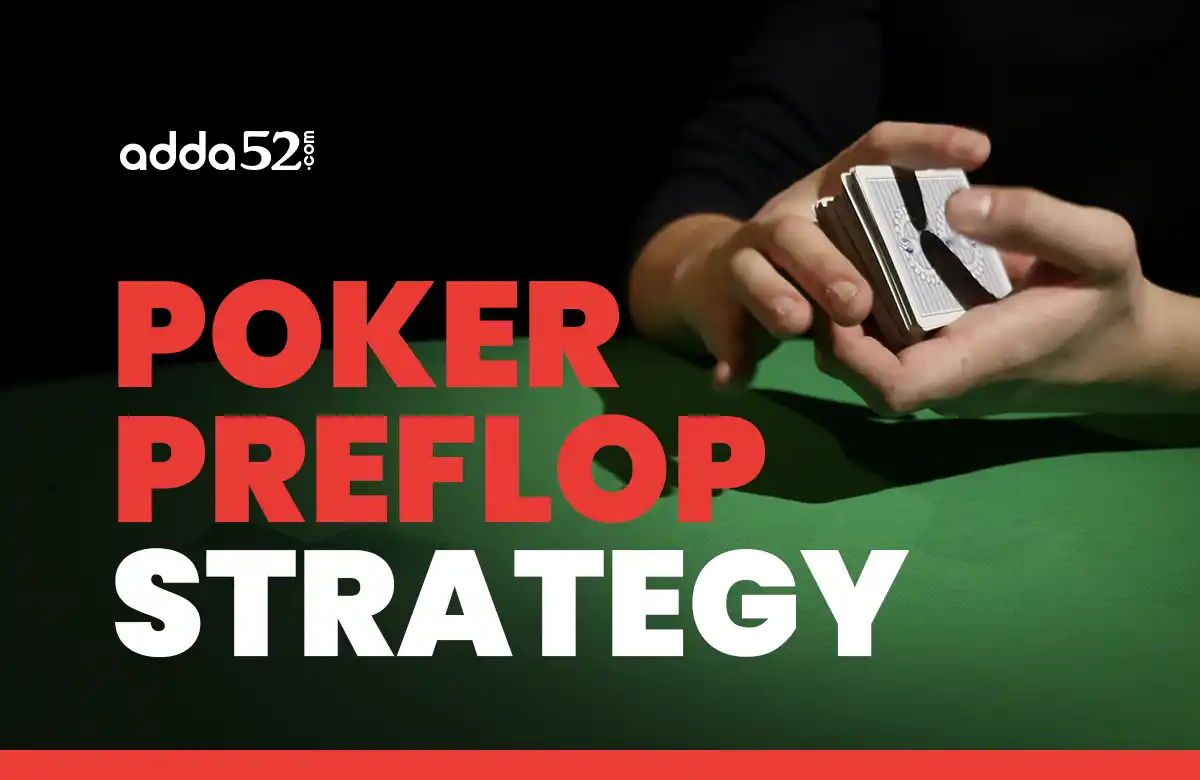
Introduction
Preflop play is crucial because it sets the stage for the entire hand. A well-thought-out preflop strategy can help you make profitable decisions and position yourself for success later in the hand.
In this article, we will explore the essential elements of the Poker preflop strategy.
What is Preflop Play?
Preflop play is the phase of Poker that occurs immediately after players receive their two-hole cards and before any community cards are dealt. During this phase, players assess the strength of their cards and decide whether to fold, call, or raise. Preflop play focuses on creating an advantageous starting position for the hand by applying the right strategy.
Pre-Flop Poker Strategy
-
Starting Hand Selection
Starting hand selection is the most fundamental aspect of the pre-flop strategy. You aim to play hands with a good chance of holding up post-flop or improving. Your hand's strength depends on the game you are playing and your position at the table. The stronger your hand, the more aggressive you can be pre-flop.
Strong Starting Hands
These are the premium hands you should aim to play from almost any position:
- Pocket Aces (AA)
- Pocket Kings (KK)
- Pocket Queens (QQ)
- Ace-King Suited (AKs)
Good Starting Hands
These hands are strong but slightly riskier and should be played from favourable positions:
- Pocket Jacks (JJ)
- Pocket Tens (TT)
- Ace-Queen Suited (AQs)
- Ace-Jack Suited (AJs)
- King-Queen Suited (KQs)
Speculative Hands
These hands are less likely to win outright but can hit strong flops (straights, flushes) and have implied odds:
- Suited Connectors (9-8s, 8-7s, etc.)
- Small Pocket Pairs (66-22)
- Suited Aces (A2s-A5s)
Hands to Avoid
Weak hands that often lead to trouble should be avoided unless you are in the right situation or playing against weak opponents:
- Offsuit hands like K9o, QJo, and JTo
- Low unsuited hands like 72o, 83o, etc.
-
Positional Awareness
The position is one of the most critical factors in preflop decision-making. The later your position at the table, the more information you have about your opponents' actions, allowing you to make more informed decisions. Your preflop strategy should adapt based on your position.
Early Position (Under the Gun, UTG)
- Since you are acting first, you should play only the strongest hands (e.g., AA, KK, QQ, AKs).
- Tighten your range to avoid being out of position post-flop.
Middle Position
- You can widen your range slightly to include hands like AQs, AJs, and middle pairs.
- Keep in mind that players in later positions can still act.
Late Position (Cutoff, Button)
- In the late position, you can play a wider range of hands as you have more information about your opponents' actions.
- Hands like suited connectors, weaker broadways, and small pairs are more playable here.
- You can use your position to steal blinds or pressure weak opponents.
Small Blind and Big Blind
- Defending your blinds should be done cautiously. You will often be out of position, so only defend with hands with strong equity or playability post-flop (e.g., suited connectors, mid-pairs).
- You can also use aggressive 3-bets to defend your blinds when facing weak steal attempts.
-
Open Raising vs. Limping
Generally, open-raising is far superior to limping in most games. Raising accomplishes multiple goals:
- Builds the pot with your premium hands.
- Applies pressure on your opponents, forcing them to play more honestly.
- Narrows the field, making it easier to win the pot.
Limping (just calling the big blind without raising) should be avoided, as it gives away initiative, leaves you vulnerable to raises, and often results in multi-way pots where your hand equity decreases.
-
3-Betting and 4-Betting
A 3-bet refers to reraising an initial raiser, while a 4-bet is reraising a 3-bet. These moves are powerful tools in preflop strategy and can indicate strong hands or aggressive bluffing.
When to 3-Bet?
Value: With premium hands like AA, KK, and AK, 3-betting is the correct play to build the pot and isolate an opponent.
Bluffing: You can also 3-bet lighter hands like suited connectors (e.g., 98s) or weaker broadways (KQs) against loose players who open-raise frequently.
When to 4-Bet?
Value: 4-bet with your absolute best hands, like AA or KK, especially against opponents who 3-bet light.
Bluffing: Advanced players can use 4-bet bluffs with blockers (e.g., Ax hands), but this requires a deep understanding of your opponent's tendencies.
-
Cold Calling vs. Folding
Cold calling (calling a raise without raising yourself) can be effective in certain spots, but it’s also dangerous if overused. The danger lies in giving the initiative to the original raiser and potentially getting squeezed by players behind you.
- Cold call with hands with great post-flop playability (e.g., suited connectors, small pairs).
- Avoid cold calling with weak or dominant hands (e.g., ATo, KJo).
-
Stealing the Blinds
In tournaments and cash games, stealing the blinds (raising from the late position to win the blinds and antes) is a crucial part of the preflop strategy.
- You can open-raise from the Button or Cutoff with a wider range of hands, especially if the blinds are tight or weak.
- Defend against steals with 3-bets from the blinds if you identify someone frequently trying to steal.
-
Adjusting for Opponents
Your preflop strategy should adapt based on your opponent's style of play:
Tight players: Open-raise more often and steal their blinds. If they 3-bet, they likely have a premium hand.
Loose players: Tighten your hand range and punish them by raising when you have strong hands.
Aggressive players: Be prepared to 4-bet bluff occasionally, and avoid over-calling their raises with weak hands.
-
Stack Sizes and Bet Sizing
In both cash games and tournaments, stack sizes affect your preflop strategy.
Deep stacks (100 BB+): You can afford to play more speculative hands and set up larger post-flop pots.
Short stacks (20-40 BBs): Your preflop decisions must maximize value and minimize risk. Focus on tighter, more aggressive play, especially in critical chip preservation tournaments.
Bet sizing also matters:
Standard Raise Size: A typical raise is 2-3x the big blind. You can size up in deeper stacks, while 2x is often enough in short stacks.
3-Bet Size: Typically 3-4x the original raise amount. Use this sizing for both value and bluff 3-bets.
Frequently Asked Questions
How do you decide which hands to play preflop?
Base your decisions on position, the situation on the table, and the opponent’s playing style. Strong hands like AA, KK, or AK should be raised in any position, while speculative hands like suited connectors are better played from late positions where the cost of entry is lower.
Should you always raise preflop with premium hands?
Yes, raising with premium hands like AA or KK helps build the pot and narrows the field, increasing your chances of winning. It also forces opponents to make tougher decisions and prevents them from seeing cheap flops with speculative hands.
When should you call pre-flop instead of raising?
Call when defending the big blind against late-position raises or when you want to see a cheap flop with speculative hands like small pocket pairs or suited connectors. Avoid excessive calling, as it can lead to tough post-flop situations.
Conclusion
Solid preflop decisions lead to improved results over the long run. Mastering the preflop phase takes practice, but the effort pays off in the form of more manageable post-flop scenarios. The pre-flop stage is where experienced players separate themselves from the rest. You should take full advantage of this opportunity to make every move count.
